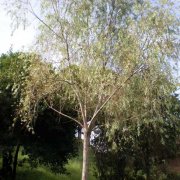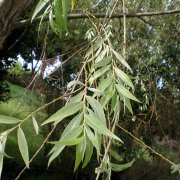Care of the tree Salix alba or White willow |
|
The genus Salix, family Salicaceae, includes some 400 species of trees and shrubs native to temperate and cold regions of the Northern Hemisphere. Some species are: Salix alba, Salix caprea, Salix baylonica, Salix fragilis, Salix cinerea, Salix purpurea, Salix arbuscula, Salix viminales, Salix atrocinerea, Salix vitellina. Common names: White willow, Swallow-tailed willow, Huntingdon willow. This species is native to Europe and western and central Asia. They are dioecious deciduous trees with a wide crown and gray bark that reach 25 meters (82 feet) in height. The leaves are up to 10 cm (3.93") long, have a lanceolate shape, the margin is dentate and are light green on the upper surface and silver on the underside. The small flowers appear in yellowish catkins. They bloom in early spring. White willow is used as isolated specimens and in groups on banks. It is not recommended to plant it next to buildings or pipes due to the large extension of the roots. Salix alba needs full sun exposure and a mild climate. It has good resistance to frost. Swallow-tailed willow grows in any type of soil that has poor drainage, even heavy calcareous soils. Water frequently so the substrate never dries completely. White willow does not resist drought. Fertilize in autumn with compost or manure. White willow can be pruned in late winter to keep them compact. Salix alba is a quite resistant plant to the usual pests and diseases but it can be attacked by some fungi. Huntingdon willow is propagated by cuttings in fall or winter and from seeds sown in spring. |
Images of the tree Salix alba or White willow |
Find plants
Salix alba or White willow | Care and Growing
© 2026 FavThemes

